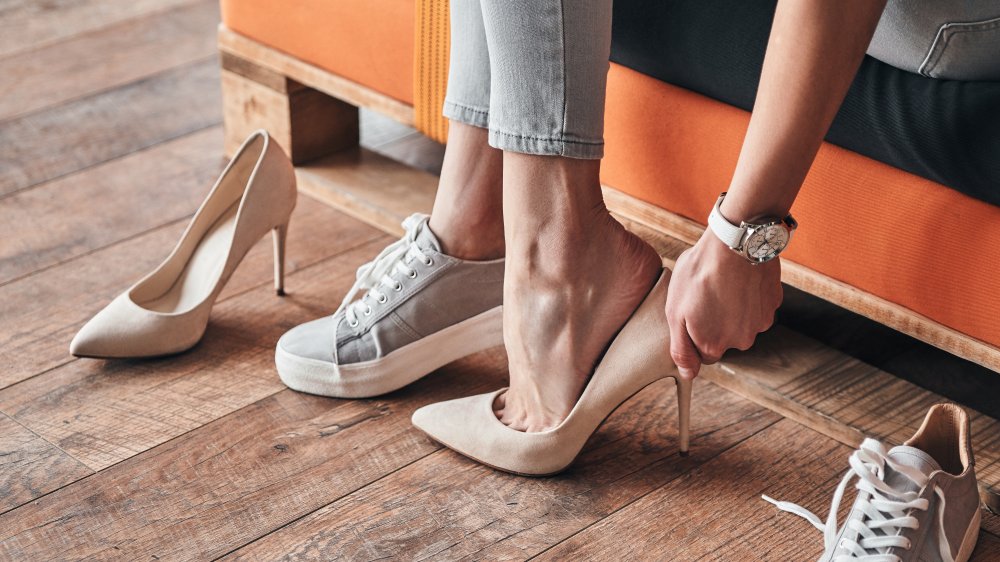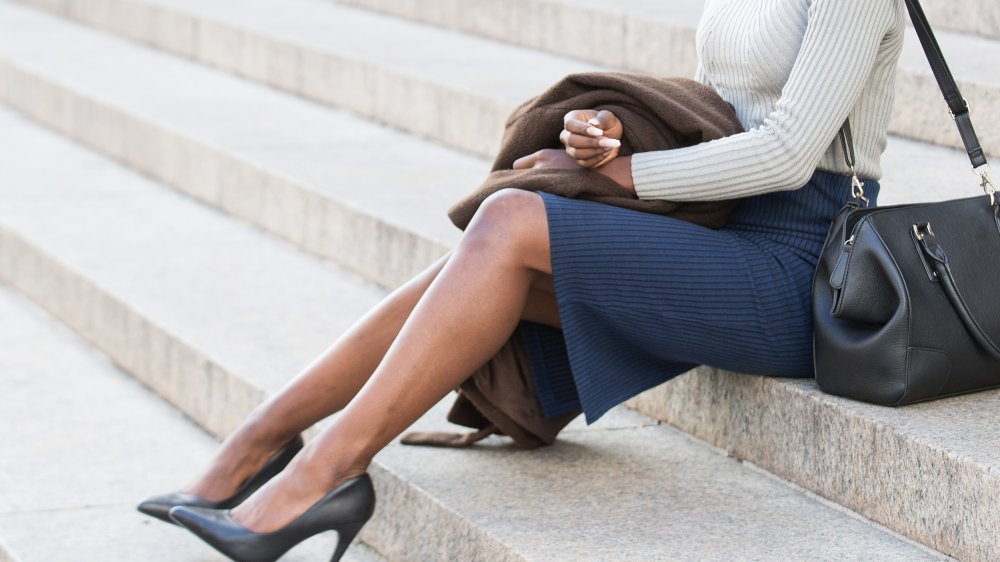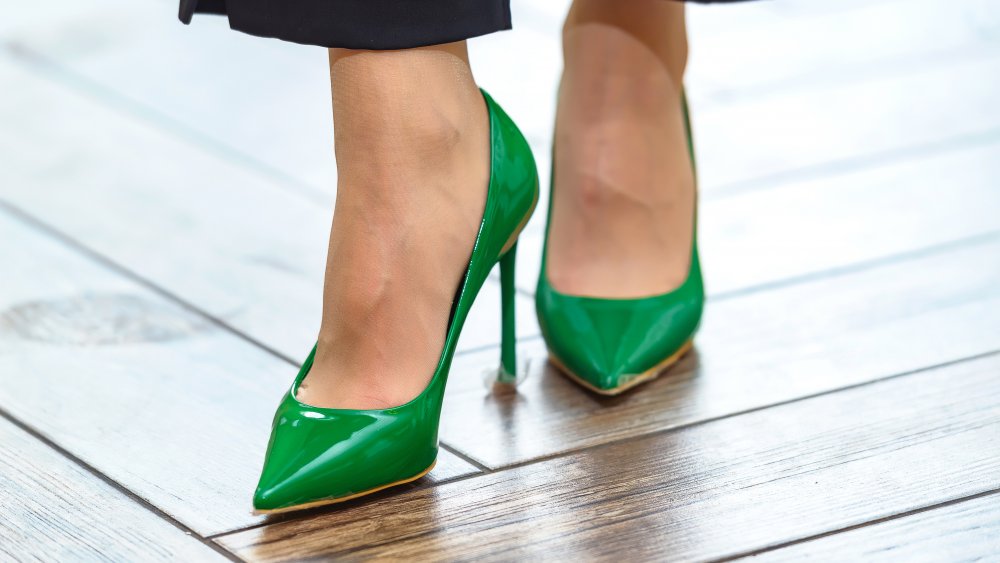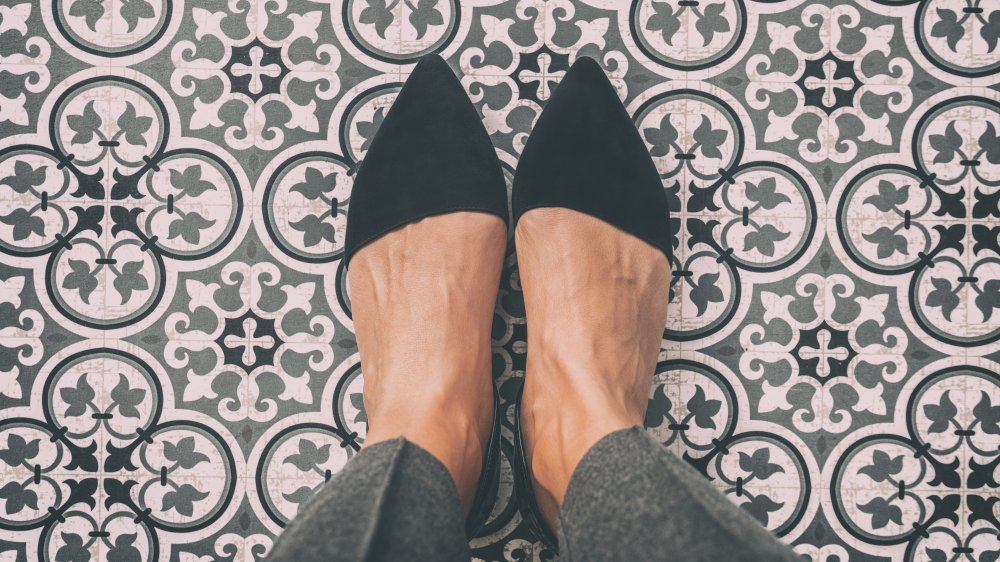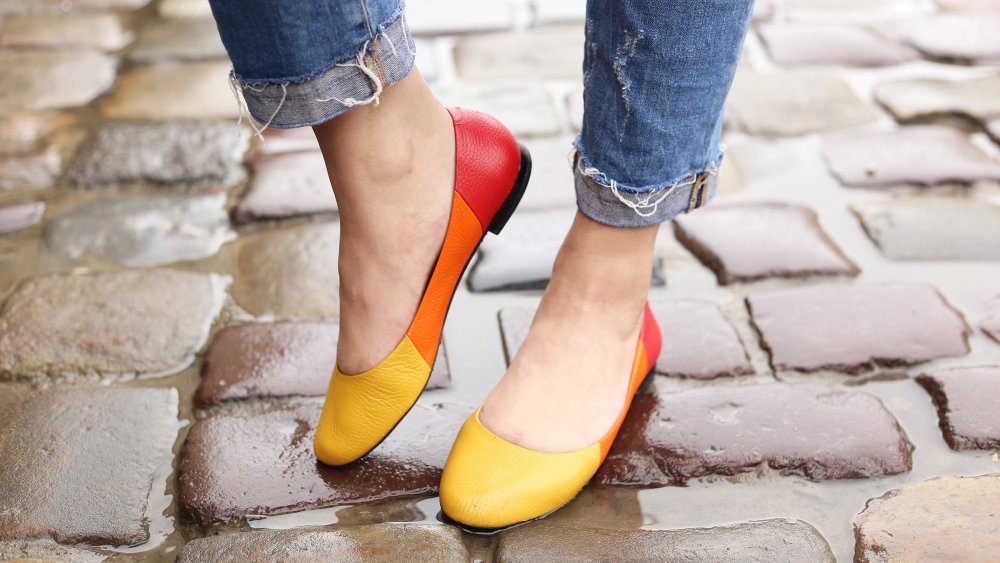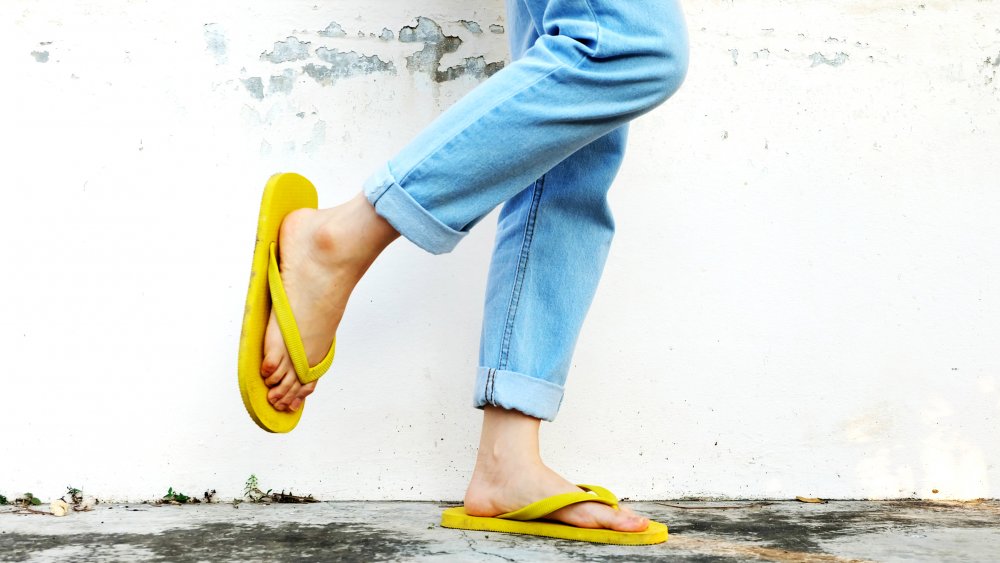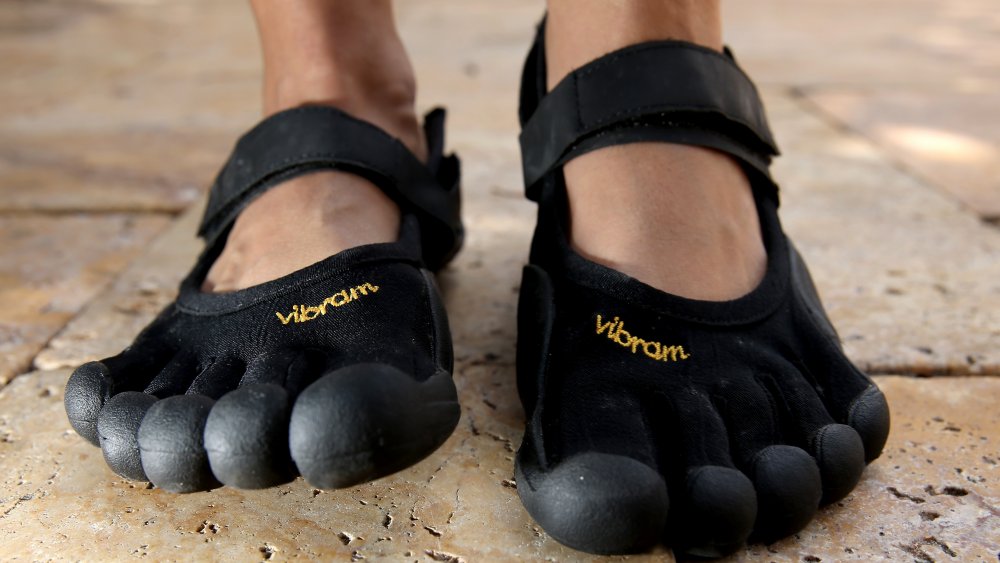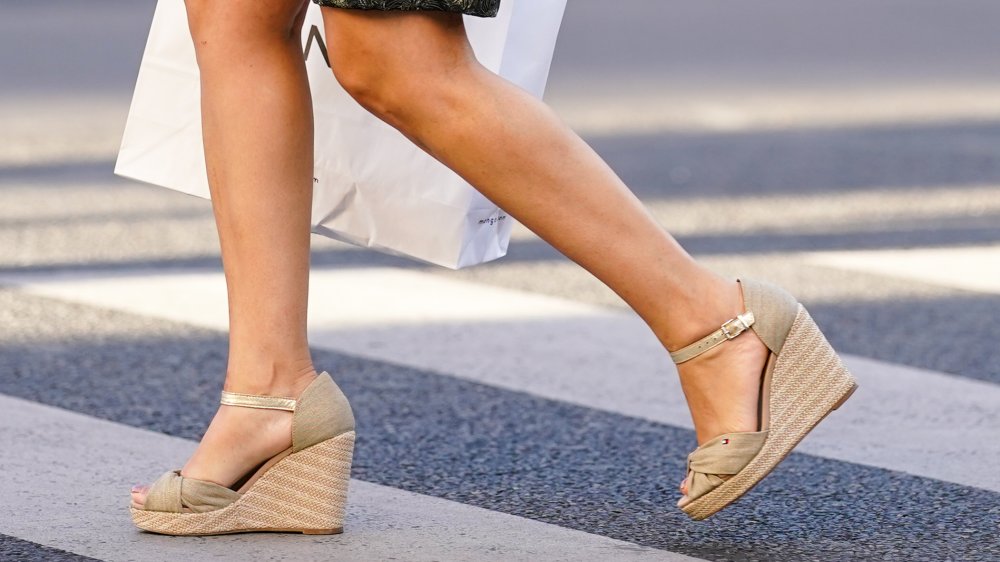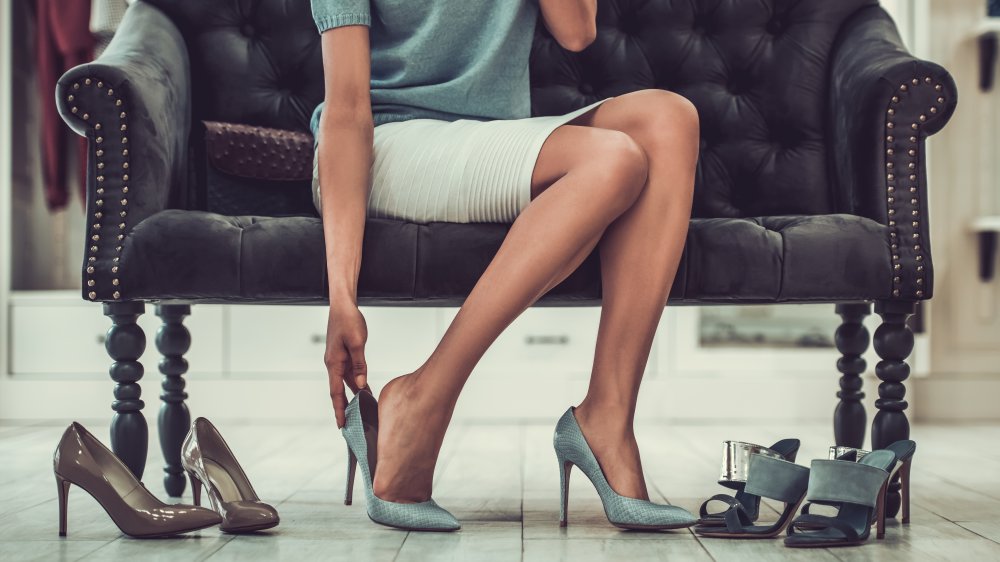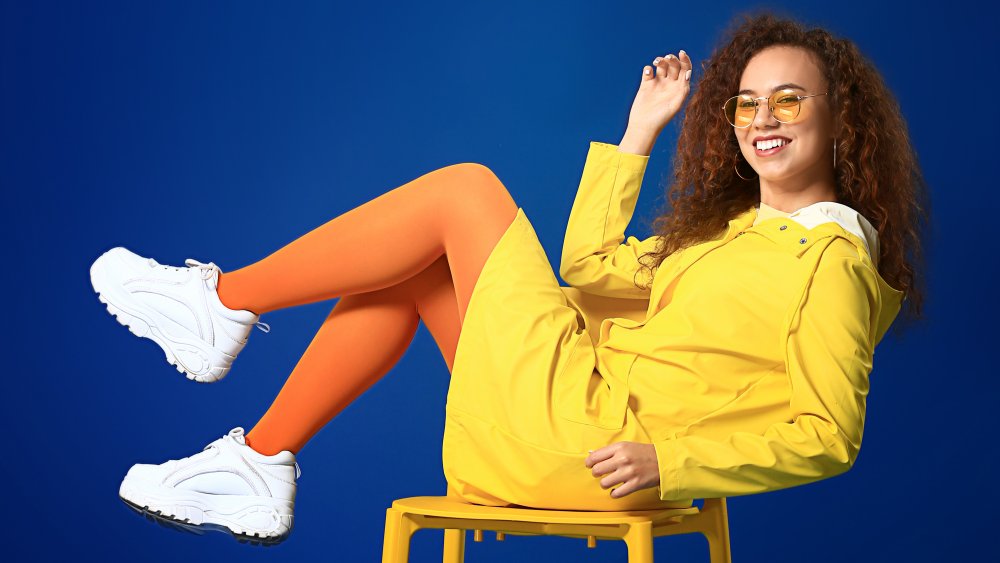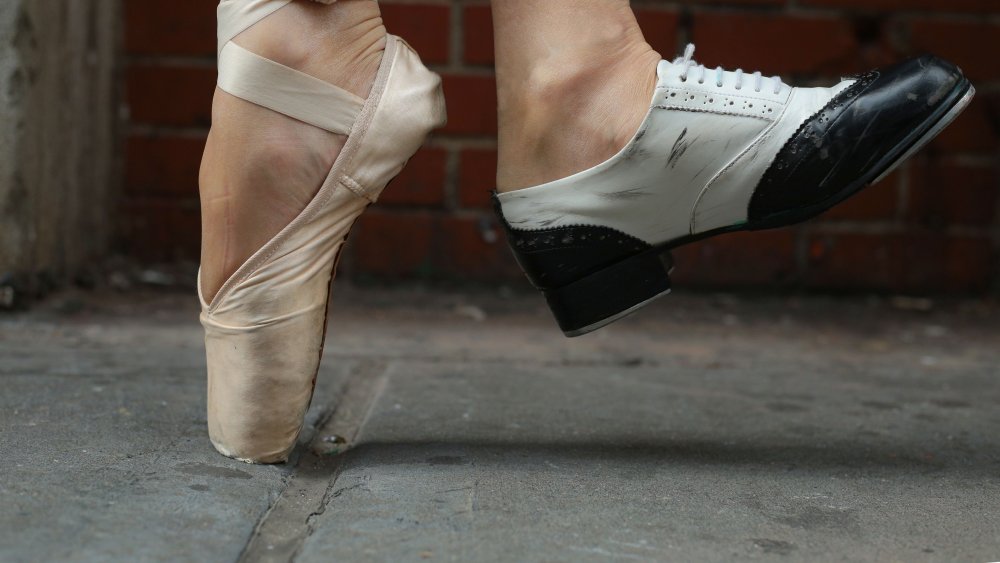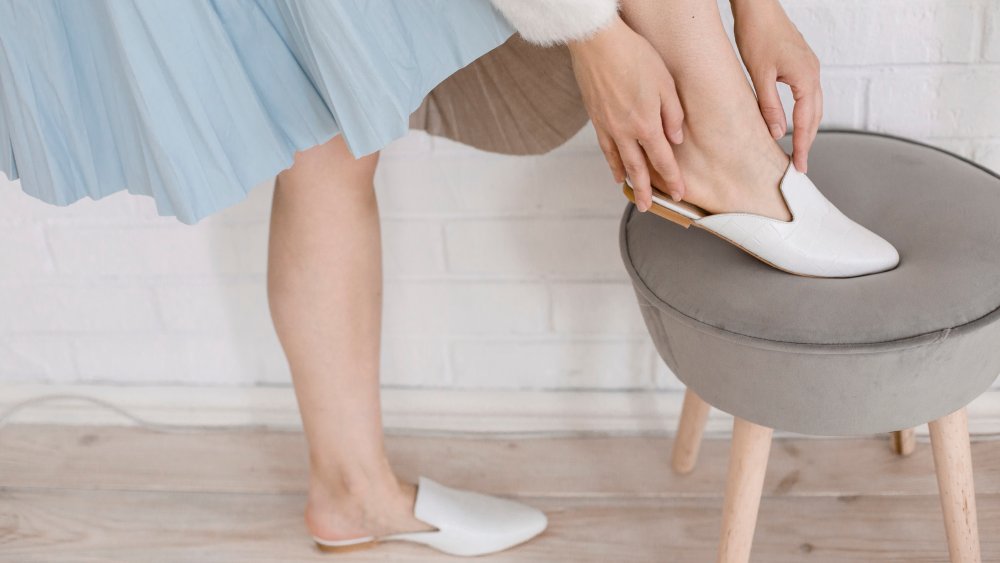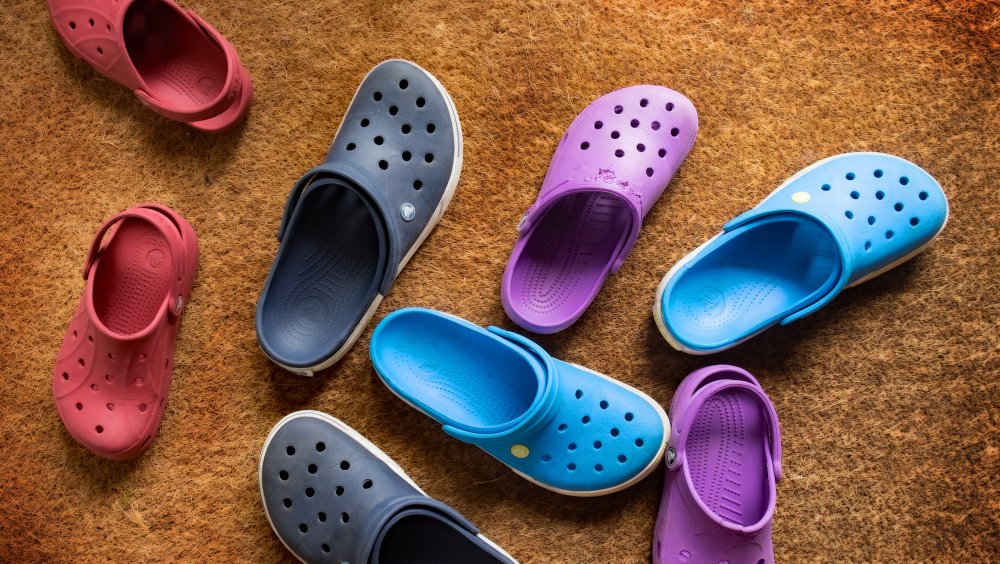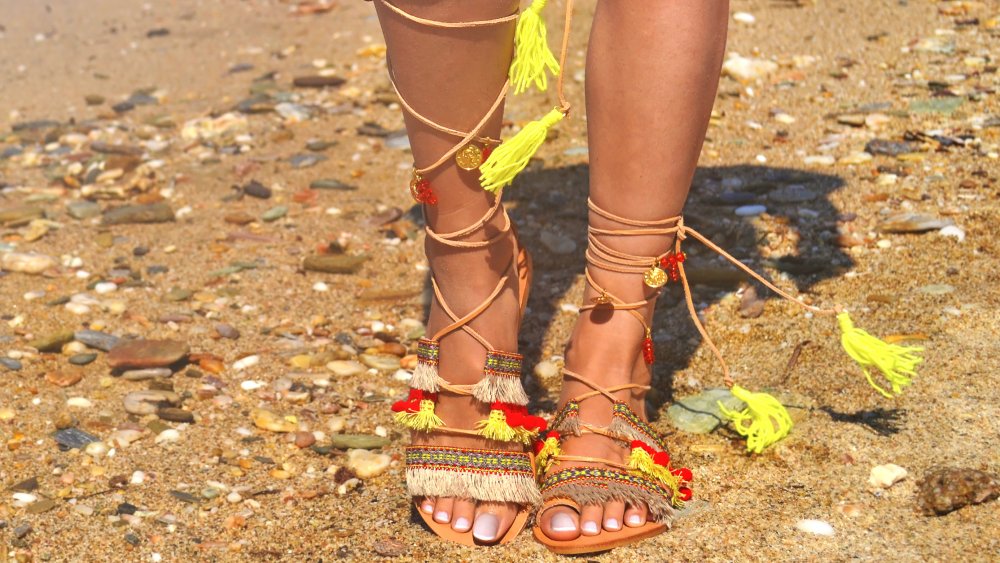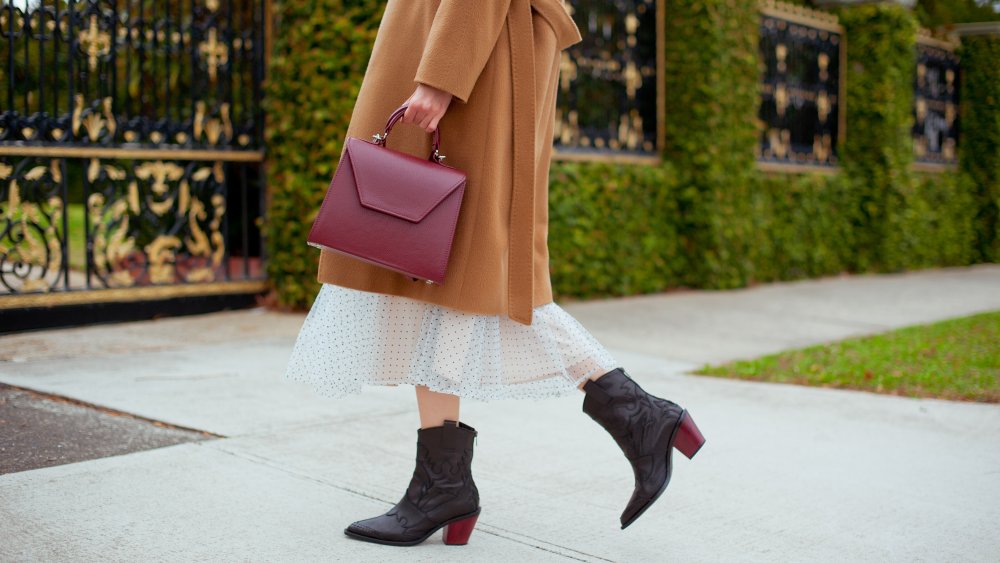Shoes That Could Be Doing Serious Damage To Your Feet
The shoe makes the outfit, right? Any fashionista will tell you that it is undeniably true — a classic pump or trendy stiletto can complete your oh-so fabulous look. And if beauty is pain, well, we can all suffer a little bit for the sake of style, no? After all, what's a hammertoe or two when you have got a gorgeous pair of Jimmy Choos just waiting for their big ensemble debut. But the truth is: wearing a pair of platforms, mules, boots, wedges, or even trendy sneakers can cause more than a little nagging arch pain. They can actually do some serious harm to your feet, legs, back, and whole body.
Even shoes you might think to be good for your feet can do some damage. Before you slip on a brand new pair of shoes and potentially suffer the unpleasant consequences (hello, ingrown toenails), read up on all the ways your favorite footwear may be damaging your feet.
High heels are all kinds of bad for your feet
Jackie Sutera, a podiatric surgeon, explained to Self how heels of all sorts can do damage, saying, "The reason heels are bad is because when you are in any kind of shoe that has elevation or a heel, your weight gets shifted forward to the ball of the foot. The higher the heel, the more weight and pressure get shifted forward." The expert continued, saying, "Your knees and hips then have to push forward and your back has to hyperextend backwards to counterbalance."
In other words, your favorite pair of height-boosting shoes puts your whole skeletal system out of whack. Repeated wearing of heels can also cause a shortening of the Achilles tendon, and result in pinched nerves of the foot, heel spurs, and arthritis, as noted in the article.
Ditching your heels is the best option, but if you want to keep your pumps, there are some things you can do. Change up your shoe options throughout the week so your feet are not perpetually wedged at the same unnatural angle, wear comfy "commuter shoes" to and from the office, and massage and stretch out your legs, feet, and toes at the end of a long day (via Self).
Stilettos add insult to injury
All heels are foot offenders, but stilettos are the worst of them all. As noted by WebMD, "the ultra-narrow heels of stilettos are particularly risky because the weight is pinpointed on one small area." This can, as the publication pointed out, cause you to "wobble like you're walking on stilts."
You may be more prone to untimely trips, spills, and ankle twists while wearing these super skinny heels. And if you will be out and about imbibing or if you are just naturally unsteady on your feet, this can be especially dangerous, as noted by Self. A thicker, chunkier heel, on the other hand (foot?), can better distribute your weight and make falls less likely.
And sad as it may be, once your prized Louboutin stilletos are worn out, it's time to move on and let them go. Podiatric surgeon Jackie Sutera told Self, "I don't care how much money you spent, they will hurt you if they're not in good shape."
Pointed-toe shoes are problematic
Those Wicked Witch of the West pointed-toe shoes are pretty much torturing your little piggies. According to Piedmont Healthcare, these offenders "scrunch your toes together" — and the crowded condition is made even worse by the presence of a heel. Height or no height, though, a triangular front can exacerbate bunions (the "hard lump on the joint of your big toe").
Worse yet, the unnatural "positioning of your toes" can also cause hammertoe, a condition where your toes "contract and eventually curl under permanently." According to Healthline, hammertoe can often be treated using inserts, cushions, pads, and medications. However, in severe instances, a surgeon may have to remove damaged bone or reposition the affected area.
Furthermore, according to podiatrist Andrew Shapiro, pointed-toe shoes can lead to neuroma, "an inflammation of the nerve between the toes" that causes pain and a perpetual burning sensation. The condition is typically treated with injections, but sometimes surgery is required (via WebMD).
Flats are failing your feet
Worse than any heel or stiletto are, according to podiatrist Robert Khorramian, ballet flats, which lack support for your barking dogs. The expert told Who What Wear that treading excessive ground in these slip-on shoes can cause "metatarsalgia neuroma and plantar fasciitis." They also damage "the fatty tissue underneath the feet," resulting in painful corns and calluses. The lack of arch cushion can also result in injuries that extend from the feet to the knees, explained podiatrist Megan Leahy in Vogue. Even back, shoulder, and hip injuries can result from ballet flats.
Nevertheless, a simple pair of flats can be more comfortable than heels, which is why Dr. Khorramian advises finding ones that offer a "cushiony sole." But if you have heel pain caused by frequent flat wearing, your podiatrist might make an unlikely suggestion: Return to heels for a bit. Dr. Leahy told Vogue that two inches of height will redistribute the pressure off your Achilles tendon to help ease the pain associated with planter fasciitis.
Flip-flops are definite flops
At the first hint of warm weather, you may dig out your flip-flops, planning to live in them all season long. But is that really a good idea?
There are a plethora of ways those rubber toe thongs are hurting your feet and your body. First, as noted by The Healthy, they offer little to no arch support, which can make you more prone to tipping and tripping. Furthermore, in the same way that ballet flats can wear down your arch tissue, so can flip-flops — potentially causing a painful case of plantar fasciitis or pinching heel spurs, podiatrist Eunice Ramsey-Parker, explained to the site. And if you find yourself perpetually curling your toes to keep the sandals in place, hammertoe is another likely consequence.
Flimsy flip-flops can also leave your foot more vulnerable to glass shards, splinters, nails, and other dangerous debris that can pierce through the rubber of the sole. Plus, who among us hasn't had the toe thong of a well worn flip-flop completely break at the most inopportune moment? While you may consider keeping a spare pair handy, the best option is to forgo the flip-flops for more supportive shoes (via The Healthy).
Natural or minimalist shoes aren't always all they're cracked up to be
Those futuristic-looking minimalist shoes that look sort of like toe socks are a step up from bare feet. As noted by Verywell Fit, minimalist footwear is "lighter than 'traditional' running shoes," and designed to "mimic the way you would naturally" move sans shoes. Since they are "lower to the ground and offer less cushioning," they could possible help you feel more connected to the earth and, ultimately, regulate your pace. More importantly, though, these options protect your delicate feet from splinters, glass, pebbles, and other potential ouchies while you're on the move outdoors. So, yes, if you like the barefoot sensation, minimalist shoes are certainly better than nothing.
All things considered, though, they are not the best shoe option and come with their own set of drawbacks. Podiatrist Hillary Brenner shared her expert opinion on the naturalist trend with OnHealth, and her take wasn't all that favorable: "There's no support for your heel or arch and no shock absorption." What's more, the site noted that the so-called "fingers" that part each toe could disrupt one's "natural walking position."
Platform wedges will give you foot woes
Platforms might seem like a decent footwear option considering the thick heel, but they also often feature "rigid foot beds," as noted by WebMD, which can impede your ability to move properly. Furthermore, if your platform has a high heel, it can put too much "pressure on the metatarsal bones." While still not perfect, a platform with less of an angle could be a healthy compromise. As recommended by the site, try to find one that is "nearly parallel with the ground" to take the weight off the ball of your foot.
And don't be fooled: Platform sneakers are not the same as regular sneakers. Podiatrist Miguel Cunh told Sunday Riley, "When compared to traditional athletic shoes, platform sneakers compromise performance for the sake of fashion, adding more strain to our feet with every step. The extra weight and height of these shoes can not only increase the demand on the muscles on the front of the shin, but they also place more stress on your entire body with every step." It's true that sometimes fashion will trump function — but whatever you do, don't wear these so-called sneakers to the gym.
Ill-fitting shoes are a big no-no
If you are squeezing your feet into the wrong size shoes in the name of fashion, you could be doing major damage to your body. In a study published in the Journal of Foot and Ankle Research, 63-72 percent of participants were found to be rocking footwear that did not properly fit their feet in terms of either width or length. Furthermore, there was found to be an association between incorrect shoe size and greater foot pain and deformities — perhaps not groundbreaking news, but noteworthy nonetheless.
Additionally, according to Verywell Health, incorrect shoe size can lead to peripheral neuropathy, or painful tingling in the feet and a "decreased ability to feel where the feet are in space." Too-small shoes can also cause ingrown toenails that lead to an infection.
It's a common misconception that, once you reach adulthood, your foot size won't change. But it can and does — as you age, when you are pregnant, or even if you have a condition or take medications that cause swelling. Yes, your foot size might not be the same as it's always been. This is why it's important to get measured from time to time.
Trendy sneakers can cause or worsen foot pain
Chuck Taylors look cute with jeans, sweats, and dresses — plus, they are relatively comfy. How could a podiatrist argue with that? Well, as it turns out, foot doctors have a lot to say about this kind of footwear. Podiatrist Leslie Campbell told HuffPost that Chucks are basically a "glorified sock without adequate support or stability and minimal to no shock absorption." She elaborated, "For those who have no particular foot complaints (pain), they are designed for the consumer moved by fashion and trends, not the individual seeking foot health." Dr. Megan Leahy echoed that statement in the same article, explaining that wearing them regularly can cause arch pain, heel pain, and even tendinitis.
Dad-inspired chunky sneakers aren't necessarily any better. Podiatrist William Joyce told The Guardian that the heavy soles "can increase the demand on the muscles on the front of the shin." So what should you look for a sneaker? According to podiatrists quoted in The Healthy, you want them to fit well, be breathable, have a wide toe box, and a flex point that matches that of your foot.
Dance shoes can do serious damage to your toes and feet
If you have ever been a novice ballerina — even as a child — you know that moving up to pointe shoes is a major dance-life milestone and a big-deal celebration.
The hard toe of pointe shoes can hold a dancer's weight. Nevertheless, dancing on pointe or in pointe shoes can lead to damage to the foot, ankle, and shin. Those who pursue ballet as professionals may be especially prone to chronic inflammation, corns that can become ulcers, hammertoe, and other unpleasant conditions. Even amateurs who move in regular ballet shoes or other types of dance shoes may be prone to a few lesser injuries, like blisters and calluses, ingrown toe nails, and bunions to name a few (via Healthline).
If you are a dancer — or a budding one — it is important to talk to your doctor about your foot health, and seek out a podiatrist for injuries and treatment plans. Your feet are your art form after all.
Mules aren't doing your feet any favors
The British Chiropractic Association made a list of the most offensive clothing and accessory items that are messing up women's backs and, lo and behold, backless shoes (aka mules) made the top five.
As noted by Glamour, this trendy type of shoe offers zero support to the ankle and back of the foot, and this puts extra pressure on your legs and lower back. The same goes for mules with heels. In fact, according to podiatrist Miguel Cunah, "It's worse to have a heel that doesn't support the back of your feet." He elaborated in an interview with HuffPost, saying, "In addition to the extra weight on the front of your feet, you also have to curl your toes to make sure the shoe doesn't fall off to the side every time you plant your foot down." Plus, mules with a heel put you at a greater risk of tripping and spraining your ankle.
Crocs clogs may be comfy, but they're not very supportive
As noted by podiatrist Megan Leahy in HuffPost, Crocs are fine for occasional use — a quick trip to the mailbox or a jaunt to the beach — but prolonged use of these rubbery clogs can lead to all sorts of problems. And we're not just talking about the inevitable fashion faux pas. So maybe save your favorite Crocs clogs for gardening or wearing around the house.
It is worth mentioning that Crocs did make a line specifically for the medical community, Crocs Rx. The Foot and Ankle Associates of North Texas noted on its site that these were made to offer additional support and to help people who are frequently on their feet. The improved insole and wide toe may have helped with an array of foot ailments. The experts at the podiatry practice even asserted that some Crocs Rx shoes were actually better suited for support than many high-end athletic sneakers. Although this line has been discontinued, some Crocs At Work shoes are comparable.
Your legs and feet won't be glad you chose gladiators
Luis Navarro, surgeon and medical director of The Vein Treatment Center in New York City, told Cosmopolitan that the constricting nature of lace-up gladiator sandals "put pressure on the vein walls, which can slow blood flow back to the heart," resulting in swollen legs. They can also leave impressions on your legs and feet and lead to painful blisters.
More notably, though, gladiator sandals can exacerbate spider veins. Since these are irreversible without treatment, you might want to save the Grecian gladiator sandals for special occasions. When you do decide to wear them, Dr. Navarro suggests using the "two-finger test." Simply place a finger under each strap to make sure there's sufficient room. When you're sitting or taking a break, loosen the straps to give your feet and legs a little breather. Better yet, elevate your limbs. "It will feel good immediately as it aids in circulation, drains blood flow away from the legs, and relieves pressure from your legs, feet, and veins," Navarro explained.
Cowboy boots are not made for walking
Cowboy boots: They're not just for cowboys. The trendy, hard boots with a triangular toe look fab with jeans and a tee or paired with a dress. But are they made for walking? Not so much.
We're sorry to say that while your Western flair may make a stylish statement, your chosen footwear won't keep you feeling steady on your feet. Dr. Miguel Cunha, founder of Gotham Footcare, told Well+Good that the unnatural toe shape of the boot could "exacerbate a bunion, cause hammertoes and irritate neuromas." This is why he suggests finding a pair of boots that feature a more square-shaped toe box.
Cowboy boots aren't the only style of boots that can cause issues, though. Your beloved shearling puppies known as Uggs may keep your toes warm and cozy, but they, too, come with drawbacks. Even ignoring the lack of arch support, wearing a "loose-fitting boot like Uggs" can make your "ankles roll inward." This forces the tendons to "collapse outward with every step," per NBC News. And if misalignment doesn't concern you, the potential for Ugg-induced skin infections should. Fuzzy boots and sweaty feet add up to a gnarly recipe for athlete's foot and dermatitis. Ugg or ugh? You decide — and wear at your own risk.

